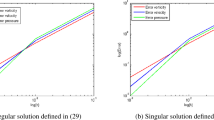Abstract
The ADER scheme for solving systems of linear, hyperbolic partial differential equations in two-dimensions is presented in this paper. It is a finite-volume scheme of high order in space and time. The scheme is explicit, fully discrete and advances the solution in one single step. Several numerical tests have been performed. In the first test case the dissipation and dispersion behaviour of the schemes are studied in one space dimension. Dispersion as well as dissipation effects strongly influence the discrete wave propagation over long distances and are very important for, e.g., aeroacoustical calculations. The next test, the so-called co-rotating vortex pair, is a demonstration of the ideas of the two-dimensional ADER approach. The linearised Euler equations are used for the simulation of the sound emitted by a co-rotating vortex pair.
Similar content being viewed by others
REFERENCES
Dahl, K. S. (1996). Aeroacoustic computation of low mach number flow. Technical Report, Riso National Laboratory, Roskilde, Denmark.
Harten, A. (1994). Adaptive multiresolution schemes for shock computations. J. Comput. Phys. 115, 319–338.
Roller, S., Fortenbach, R., Schwartzkopff, T., and Munz, C. D. (2001). The numerical modeling of acoustic wave propagation using the multiple pressure variables approach. Computing and Visualization in Science, preprint.
Schwartzkopff, T., Munz, C. D., Toro, E. F., and Millington, R. C. (2001). The ADER approach in 2D. In Sonar, T. (ed.), Discrete Modelling and Discrete Algorithms on Continuum Mechanics, Logos Verlag, Berlin, pp. 207–216.
Shu, C.-W. (1998). Essentially Non-Oscillatory and Weighted Essentially Non-Oscillatory Schemes for Hyperbolic Conservation Laws. In Cockburn, B., Johnson, C., Shu, C.-W., and Tadmor, E. (Quarteroni, A. (ed.)), Advanced Numerical Approximation of Nonlinear Hyperbolic Equations, Lecture Notes in Mathematics, Vol. 1697, Springer, pp. 325–432.
Tam, C. K. W. (1996). Numerical methods in computational aeroacoustics. In Von Karman Institute for Fluid Dynamics, Lecture Series 1996–04, Applied Aero-Acoutistics.
Toro, E. F. (1997). Riemann Solvers and Numerical Methods for Fluid Dynamics, 1st edn., Springer.
Toro, E. F., and Millington, R. C. (2000). ADER: High-order non-oscillatory advection schemes. In Proc. of the 8th Intern. Conf. on Nonlinear Hyperbolic Problems, preprint.
Author information
Authors and Affiliations
Rights and permissions
About this article
Cite this article
Schwartzkopff, T., Munz, C.D. & Toro, E.F. ADER: A High-Order Approach for Linear Hyperbolic Systems in 2D. Journal of Scientific Computing 17, 231–240 (2002). https://doi.org/10.1023/A:1015160900410
Issue Date:
DOI: https://doi.org/10.1023/A:1015160900410




